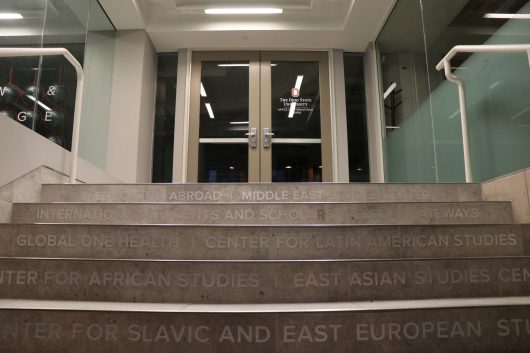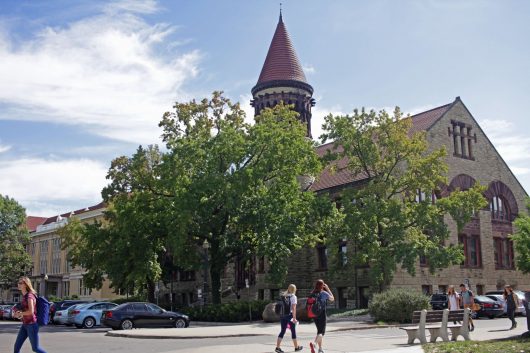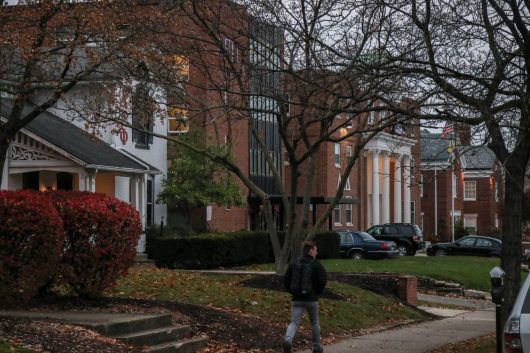It’s been a year of First Amendment issues, unprecedented announcements and political statements from Ohio State. A year that started with an Undergraduate Student Government campaign scandal and ended with an analysis on an ever-present wage gap for university employees made for interesting coverage at The Lantern.
Here are some of 2017’s top stories chosen by Lantern campus editors Summer Cartwright and Owen Daugherty.
March –
Not quite a D.C. scandal, but close?

Mary Honaker and Carla Gracia are running for Undergraduate Student Government president and vice president, respectively. Credit: Courtesy of Mary Honker and Carla Gracia
Turning Point USA, a conservative nonprofit group with university chapters across the country, decided to put its money where USG’s mouth is — kind of.
During the student government elections in 2017, TPUSA offered to fund $6,000 to Mary Honaker and Carla Gracia — though the pair denied it at first, and never admitted wrongdoing — a move that resulted in them removing themselves from the ballot.
Hillel puts funds toward USG divestment ballot issue
Ohio State Hillel joined in an opposition campaign against a USG ballot issue that requested the university divest from five U.S. companies accused of human-rights violations.
It bought advertising and had staff help organize opposition efforts behind Issue Two, a failed proposed resolution. The university is continuing its relations with the companies.
Ohio State sells energy rights or more than $1 billion

Critics of the energy deal have likened it to an off-the-books loan. Credit: Jack Westerheide | Social Media Editor
The university sold the rights to its energy production on campus for an upfront payment of $1.015 billion in April, the largest of its kind at the time. The deal created a public-private partnership with French energy producer Engie.
This continues the trend of the university privatizing its resources, which began with its CampusParc deal in 2012. The 50-year, $483 million deal was also the largest of its kind.
April-
Police data shows racial disparities in stops for suspicious activity

The Ohio State University Police Division congregated on the northern side of the Union, watching the protest from afar. Credit: Ris Twigg | Assistant Photo Editor
A Lantern analysis of University Police data showed 33 percent of field interviews involved subjects who were black.
Yet only five percent of Ohio State students are black and only one in 12 residents of the University District, the area where University Police patrol, are black.
May –
We know you know Ohio State is big.

A graduation cap from the 2017 Spring Commencement outside Ohio Stadium on May 7. Credit: Jack Westerheide | Photo Editor
You get it, we get it, but it’s kind of a big deal. Get that?
In Ohio State’s 415th commencement in May, 11,734 students from 88 countries and six continents graduated: 279 receiving doctorate degrees, 1,849 receiving master’s degrees and 8,739 receiving bachelor’s and associate’s degrees.
That set precedent a year of record-breaking numbers for Ohio State: its class of 2021 is the biggest yet.
Wexner Medical Center CEO steps down amid questions of leadership
Ohio State’s Wexner Medical Center experienced a shakeup at the top in May when CEO Sheldon Retchin stepped down following letters from top doctors criticizing his leadership.
Retchin’s absence at the center left a void that is still looking to be filled by a new role the university is calling “chancellor” of the entire medical enterprise. It also was the first of three high-profile departures from the medical center.
Although Retchin stepped down, he is still employed at Ohio State as a senior advisor to University President Michael Drake.
July-
Ohio State raises tuition and locks in prices for four years
Tuition was raised 6 percent for all incoming 2017 in-state undergraduate students before being locked in through the 2020-21 academic year as part of the Tuition Guarantee program implemented in July.
The tuition-and-fee structure now in place will raise the cost of tuition for all new students by varying rates, breaking the five-year tuition freeze Ohio State previously had.
Additionally, housing fees increased 6 percent for all students — both incoming and returning. Dining plans will also see a 3 percent swell, which will apply to all meal plans for both new and currently enrolled students.
August-
No more Post-It Note art

Students in Scott House post “Jess, Will You Marry Me?” and “Ducks 4 for Harambe” on their windows. Credit: Dominique Johnson | Lantern Reporter
Ohio State put an end to the window art fad that became prevalent in 2016 when new dorms on High Street and Lane Avenue were opened.
The dorms’ new, window-covered facades were quickly filled with Post-It Note messages, but Ohio State only allowed it to take place for one year.
In August, The Lantern discovered Ohio State had changed its dorm policy to no longer allow the window art, sparking a debate about First Amendment rights on college campuses.
September-
Richard Spencer gets denied… the first time

Richard Spencer takes questions at CPAC from reporters before he was removed from the convention on Feb. 23, 2017. Credit: Courtesy of TNS
Coming on the heels of the deadly Charlottesville “Unite the Right” rally, Ohio State rejected a request from one of the organizer’s, white supremacist Richard Spencer, to use campus space for an event to be held on campus.
This move ignited what would become a monthslong back-and-forth between the university and Spencer’s lawyer, as well as the Georgia State University student who requested for the space.
It resulted in a lawsuit filed against University President Michael Drake and the Board of Trustees, similar to others filed against Michigan State University for doing the same. While the legal process continues the question remains: Will Spencer speak at Ohio State’s campus in 2018?
Some Pell Grant recipients to receive tuition coverage
Ohio State announced in September that it will cover the full cost of tuition for some of its students.
Those that live in-state, are undergraduates on the Columbus campus and are eligible for Pell Grants and Ohio College Opportunity Grants — as well as those who come from households that make Ohio’s median income of $55,000 or less — will get their tuition covered come Autumn 2018.
An estimated 3,500 undergraduate students on Ohio State’s main campus are eligible for this tuition coverage, according to university data. The total cost each year for Ohio State to cover these students’ tuition is about $11 million.
O-H-iPad

The university is collaborating with Apple to provide not only iPads, but also an iOS laboratory, which will be introduced to Ohio State’s Columbus campus Spring 2018. Photo Illustration by: Ris Twigg | Assistant Photo Editor
Tuition coverage isn’t the only thing incoming students in 2018 can look forward to. All of the class of 2022, including those attending branch campuses, will receive a 10.5-inch, 256GB iPad Pro from the university — for free.
The university announced its plans to also build an iOS laboratory on campus in the spring, though the location is yet to be known.
DACA recipient speaks out after dismantling of program announced
An Ohio State DACA recipient took a stand days after the Trump administration announced its decision to dismantle the program that protects people illegally brought the US as children from being deported.
Though Ohio State will not release the total number of DACA recipients who attend the university in order to protect their privacy, Lidia Garcia agreed to be interviewed by The Lantern and spoke of her experience with the program.
“With DACA, I was able to do things that I never would have been able to do,” Garcia said. “I could be somebody, not just somebody invisible, but I could be somebody in life and in society.”
October-
International fee triples in three years

Ohio State Office of International Affairs in the Enarson Classroom Building. Credit: Jack Westerheide | Photo Editor
The international student population has increased from 3,440 students in Autumn 2014 to 3,691 students Autumn 2017. The international student fee has gone from $996 in 2012 to $2,928 currently.
International students who enrolled before the 2012-13 academic year pay $996; those admitted during the 2015-16 and 2016-17 academic years pay $1,932; and those admitted during the 2017-18 academic year will pay $2,928.
November –
Students involved in widespread GroupMe cheating scandal

83 undergraduate students enrolled in a marketing course last spring were caught cheating using a messaging app called GroupMe. Credit: Jack Westerheide | Photo Editor
Eighty-three undergraduate students were caught sharing answers using the GroupMe messaging app, putting some students at risk of not graduating.
The Fisher College of Business students were reported by their professor in April. They are still awaiting their consequences with the outcome of the investigation into their violations.
Ohio State suspends fraternities social activity indefinitely
Following conduct violation investigations into 11 of the university’s 37 Interfraternity Council chapters, Ohio State suspended all fraternity activity indefinitely in November.
The “proactive” decision was based on the high number of investigations, not one individual incident.
Ohio State became one of the most high profile schools to suspend fraternities, following similar decisions at Penn State, Michigan, Florida State and many others.
Officer details campus attack

Alan Horujko shot and killed the Nov. 28 attacker within 53 seconds of pursuit and recounts his story in a university-produced interview. Credit: Ohio State
The officer who shot and killed a student who attacked campus Nov. 28, 2016 spoke for the first time and recounted his experience from that day.
University Police officer Alan Horujko detailed the moments between the crash and the shots fired at Abdul Razak Ali Artan in an Ohio State-produced video released to the public one year after the attack.
“I yelled after [Artan] multiple times, ‘Drop the knife. Drop the knife. Drop the knife.’ But he never looked back at me. Never acknowledged me,” Horujko said.
Suicide rates rise steadily among young people, at Ohio State

Emily Doleh, a first-year in chemical engineering, holds a picture of her with her older brother Adam, who died by suicide in January 2017. The two took the photo in the fall of 2016 when Emily first visited Ohio State on a college visit. Credit: Sheridan Hendrix | Oller Reporter
In an analysis that took place over the course of six months, a Lantern report shed light on a tragic truth — suicide at Ohio State. Six students died by suicide during 2016-17 academic year — an anomaly for the university, but a number reflective of the national numbers.
Ohio State Student Life’s Counseling and Consultation Service can be reached at 614-292-5766. The National Suicide Prevention Lifeline can be reached at 1-800-273-8255.
Gender pay gap prevalent at Ohio State

The gender pay gap has persisted across the decade at Ohio State, with male university employees earning about $7,811 more than female employees in 2016. Credit: Ris Twigg | Assistant Photo Editor
A Lantern analysis outlined the pay gap that still exists at Ohio State across all levels of employment.
Ohio State payroll data including thousands of employees and hundreds of job classifications found that men have consistently earned more than women in the past decade.
Last year alone, male Ohio State employees earned $7,811 more than females, when comparing all median salary values.








